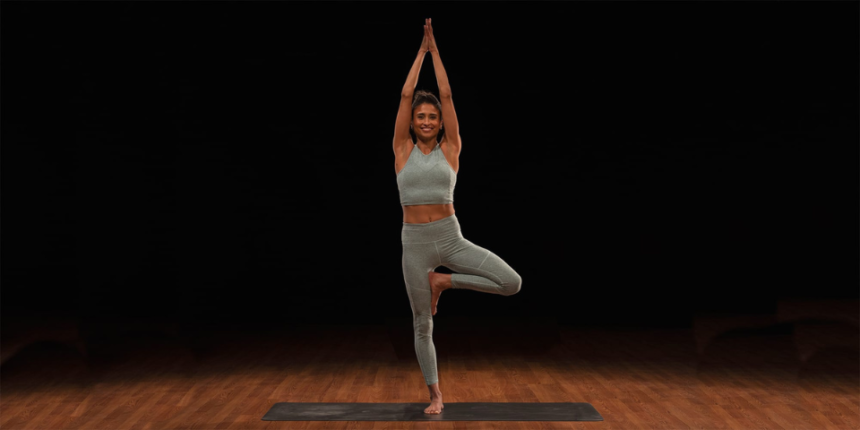Tree pose is an iconic balancing posture in yoga. Recognized in Sanskrit as vrksasana (additionally spelled vriksasana and vrikshasana), tree pose “is among the first stability poses a practitioner learns in yoga,” says Stephanie Saunders, BODi Vice President of health content material and a licensed yoga teacher.
It’s aptly named: Your legs are the trunk of your tree pose, your standing foot turns into your roots, and your arms are the branches. Tree pose is a standing stability that’s simple to customise and is suitable for college students of all ranges.
Tree Pose (Vrksasana): Step-by-Step Directions
- Stand tall in mountain pose (tadasana) — chest up, large toes touching, heels barely aside — close to the highest of your mat, along with your palms collectively in entrance of your chest.
- Shift your weight onto your left foot, and lift your proper knee.
- Swing your proper knee out to the precise, and place the only of your proper foot towards the within of your left calf or, with the assistance of your hand, your left thigh. (Don’t place it towards your knee.)
- Hold your left leg robust and straight with out locking your knee as you gaze ahead at a stationary goal that can assist you stability.
- While you really feel secure, carry your arms into place: at your coronary heart (in anjali mudra as demonstrated on this clip from Yoga52), instantly overhead, or straight out to your sides.
- Maintain for a minimum of 5 breaths, then change sides and repeat.
The way to Make Tree Pose Simpler
Balancing in tree pose isn’t purported to be simple the primary time you do it — that’s the way you get stronger. Listed below are some tricks to modify it.
- If stability is tough for you right now (it occurs!), take tree pose subsequent to a wall.
- Bringing your foot towards your internal thigh requires a certain quantity of hip flexibility. Saunders suggests conserving your foot beneath your knee and even utilizing it as a “kickstand” on the bottom (proper heel towards left ankle) till your hips open up. This prevents you from having to tilt your pelvis to maneuver your foot into place.
The way to Make Tree Pose Tougher
It’s easy to make tree pose (or any balancing pose) more durable — right here’s how one can intensify vrksasana.
- Use solely lower-body and core power, slightly than your hand, to maneuver your lifted foot into place.
- Stand along with your lifted foot hovering simply contained in the thigh or calf of your standing leg with out letting it really make contact with both.
- Shut your eyes to problem your stability — or elevate your toes.
- Steadiness on a block or softer floor, forcing the muscle groups supporting your ft and ankles to work more durable.
Newbie’s Suggestions for Doing Tree Pose
New yogis typically attempt to get into the “remaining” model of tree pose earlier than their hips are prepared. To place your foot larger in your leg, it’s worthwhile to work on externally rotating your femur within the hip socket. Deal with opening your hip earlier than placing your leg in place to maintain your knee and hip secure and wholesome.
Listed below are some further issues when performing tree pose, particularly if you’re simply starting.
- Keep away from inserting your foot towards your knee. Greater or decrease are each acceptable positions, however inserting your foot in your knee places that delicate joint in danger for damage.
- Chorus from locking your standing knee. Whereas it would really feel safer, it isn’t secure — particularly in case you begin to sway. (And you’ll, irrespective of how lengthy you’ve been training.)
- Breathe! Novices have a tendency to carry their breath in balancing poses.
- Don’t hand over the pose if you begin to falter. Keep in mind that timber sway within the wind, and so they often handle to remain upright. Wiggles and shakes are power in progress!
- In case you do lose your stability, take a breath and begin over.
Advantages of Tree Pose
Whether or not it’s your first or hundredth time doing tree pose, you possibly can get pleasure from the next advantages of tree pose.
Promotes stability
“Though irritating at instances, stability impacts each different motion our our bodies make,” says Saunders. “You may improve the standard of your actions and assist keep away from accidents with only a little bit of stability coaching. Tree is a superb place to start, and creating extra stability and power in your ft and ankles will make all stability poses extra achievable.”
Strengthens decrease physique and core
To remain balanced, it’s worthwhile to activate your core and hearth up the small muscle groups supporting your ft and ankles.
“Tree pose makes use of nearly each muscle in your decrease physique to assist preserve impartial alignment of the backbone and pelvis. The lifted leg alone makes use of 5 totally different joint actions, and a minimum of 9 totally different muscle groups.”
You’ll really feel tree pose in your quadriceps and adductors, and all the again sides of your legs — out of your calves as much as your glutes.
Opens the hips
To place your foot towards your internal thigh, you want to have the ability to externally rotate your thigh bone within the hip socket. Tight hips restrict your means to get deeper into a variety of poses, so embody vrksasana in your common yoga follow and see the way it begins to open your hips. (Simply be sure to do it on each side!)










